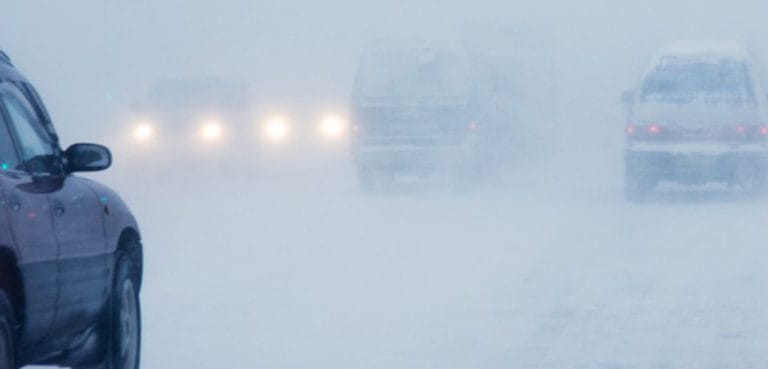13 Tips for Driving in a Whiteout

In many parts of the country, driving through wind and snow is just a part of your average winter. However, it’s not every day that you end up driving in a whiteout.
Drivers are often caught off guard when snow is being blown across roadways and visibility becomes virtually nonexistent. If weather conditions are bad enough, make an executive decision to stay home.
However, if you absolutely have to go out—or conditions aren’t quite bad enough to warrant staying home—follow these tips to help you reach your destination safely.
Slow down. Speed limits are set for summer conditions, when snow and ice aren’t an issue. (Check out our full list of driving don’ts.) If you’re driving in a whiteout, drive slowly. Also, periodically check your speedometer—without visual cues passing by, it’s easy to speed up without realizing it after a while.
Avoid abrupt acceleration, braking and steering. Drive cautiously and gently to avoid slipping and sliding on the road. Also avoid jerking the wheel—overcorrections could put you in a tailspin. Instead, smoothly guide your car where you want it to go.
Don’t tailgate.This is important at any time, but especially when you’re driving in a whiteout. Leave more room than you normally would between your car and the car in front of you.
Avoid changing lanes or passing other drivers. Reduced visibility makes it hard to see when someone else has the same idea.
Avoid using cruise control. Tapping the brakes to turn off cruise control can cause your tires to lose traction. If you need to slow down, take your foot off the accelerator and let your car slow down gradually.
Look beyond the car in front of you. It’s easy to lock your gaze on the taillights in front of you. It’s a better bet to keep your gaze further ahead.
Put your fog lights or low beams on. Low beams are a better choice than high beams since there’s less bounce back from ice particles in the air.
Defrost your windows. Activate the defroster for the front and rear windows. It’s best not to press the recirculate button—doing so tends to make your windows fog up more due to the increased moisture in the air.
Reduce distractions. Beyond obvious ones like refraining from texting while driving, you might consider turning off the radio, not eating or smoking, and putting any conversations on hiatus so you can really focus on the road. (The one exception: Tuning into weather reports.)
Be prepared to reroute. If a weather report says a certain area is closed off or backed up, reroute your course. The announcer often will give an alternative route.
Watch out for black ice. It’s extremely slippery and dangerous—so make sure you know how to spot it and how to handle driving on it.
Pull over. If conditions are bad enough that you can’t see the roads, put on your four-way flashers and park in a safe place off the road. Avoid going to the side of the road unless it’s an absolute emergency, as this can create a dangerous situation for you and other drivers.
Prepare an emergency kit. In case you find yourself stuck, be sure to prep a kit with essentials that can be stored in your car all year round.
Be Prepared with the Right Auto Coverage
When the snow settles and you find your car under a few extra feet of snow, ERIE’s Emergency Roadside Coverage can help cover the cost to pull your vehicle out so you can get back on the road. Contact your local Erie Insurance agent to review your coverage, or get a quote today.
ERIE® insurance products and services are provided by one or more of the following insurers: Erie Insurance Exchange, Erie Insurance Company, Erie Insurance Property & Casualty Company, Flagship City Insurance Company and Erie Family Life Insurance Company (home offices: Erie, Pennsylvania) or Erie Insurance Company of New York (home office: Rochester, New York). The companies within the Erie Insurance Group are not licensed to operate in all states. Refer to the company licensure and states of operation information.
The insurance products and rates, if applicable, described in this blog are in effect as of July 2022 and may be changed at any time.
Insurance products are subject to terms, conditions and exclusions not described in this blog. The policy contains the specific details of the coverages, terms, conditions and exclusions.
The insurance products and services described in this blog are not offered in all states. ERIE life insurance and annuity products are not available in New York. ERIE Medicare supplement products are not available in the District of Columbia or New York. ERIE long term care products are not available in the District of Columbia and New York.
Eligibility will be determined at the time of application based upon applicable underwriting guidelines and rules in effect at that time.
Your ERIE agent can offer you practical guidance and answer questions you may have before you buy.



